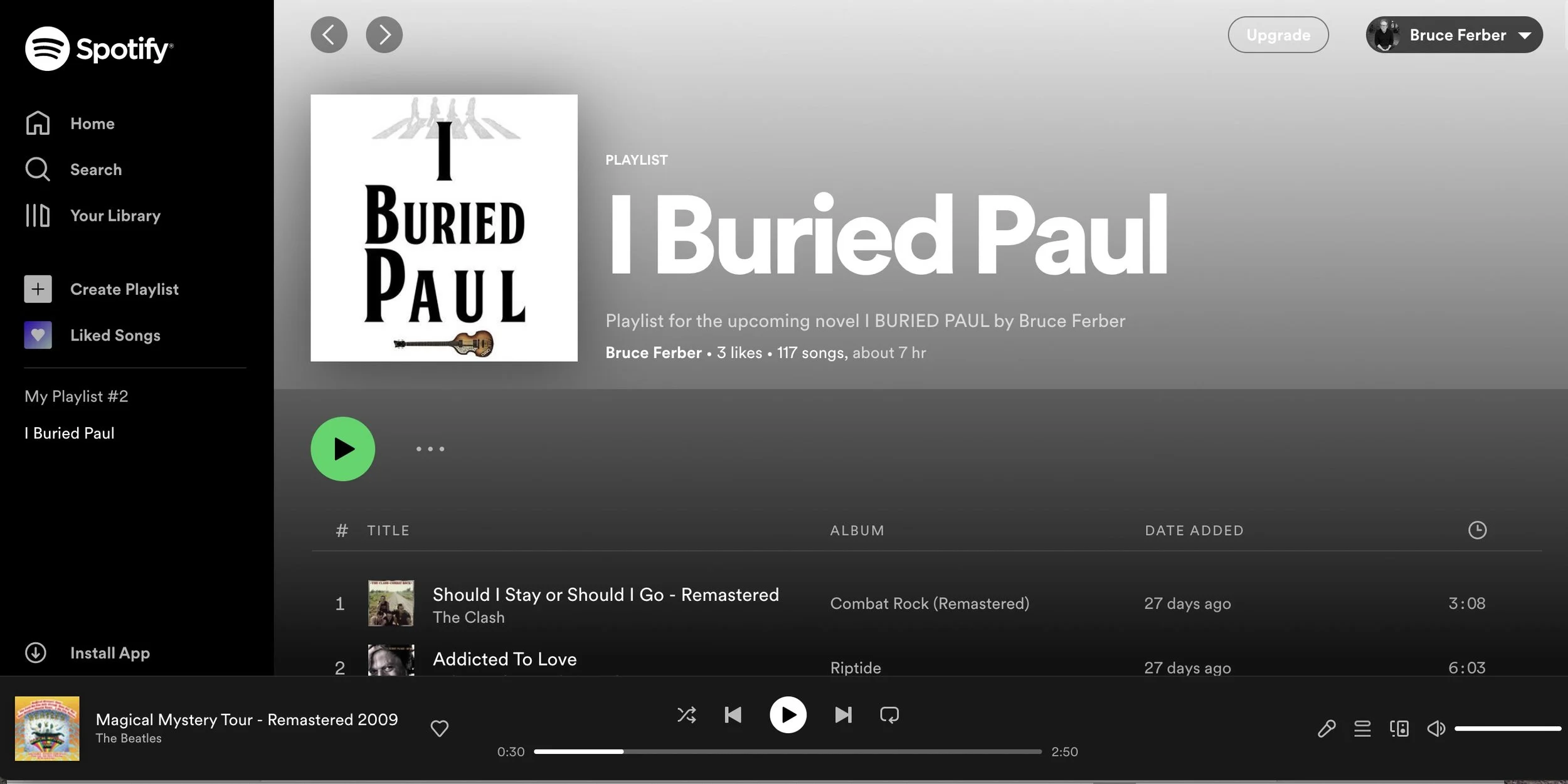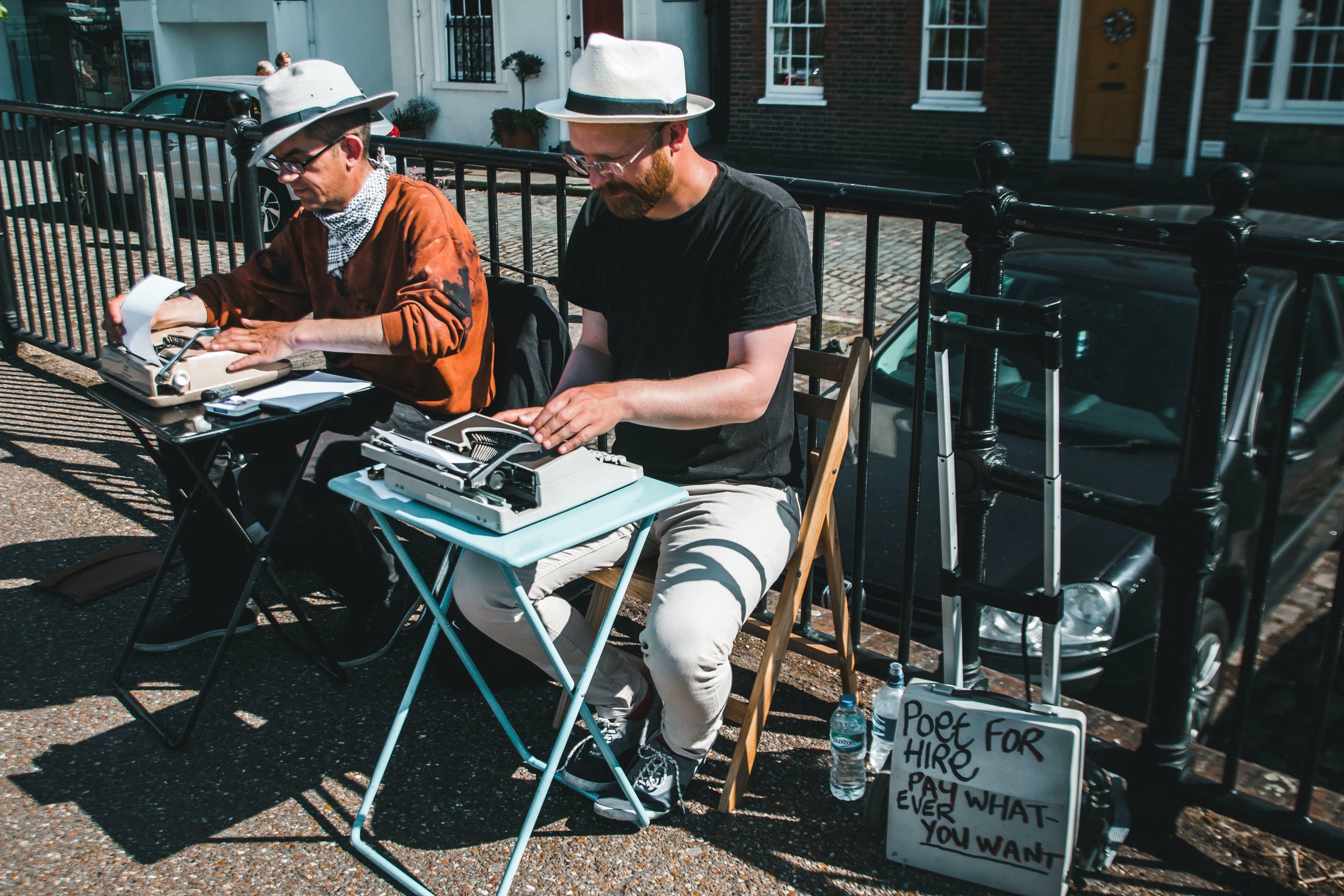Blog
The Playlist’s The Thing
We in the I BURIED PAUL camp are starting to get super excited for our June 14th pub date. Are we really a “camp?” you ask, with a tad too much snark. Full disclosure: We can’t afford a team of industry billionaires to bully skeptical readers into submission. Nor can we offer cabins on a lake. So, what’s our angle?
Photo by Feliphe Schiarolli on Unsplash
We in the I BURIED PAUL camp are starting to get super excited for our June 14th pub date. Are we really a “camp?” you ask, with a tad too much snark. Full disclosure: We can’t afford a team of industry billionaires to bully skeptical readers into submission. Nor can we offer cabins on a lake. So, what’s our angle?
In lieu of lobbyists and jet skis, Camp I Buried Paul offers a Beatles-inspired experience that explores the vicissitudes of the creative life and how that life is shaped by family. Compelling, funny… BUT THAT’S NOT ALL! Not only do we have a novel, WE HAVE A PLAYLIST!
Why is that such a big deal? In truth, it’s not unusual for an author to compile a group of songs that either influenced the book, or pair well with the substance of the final text. Maybe there was a Led Zeppelin tune that inspired the writer to include a black dog in Chapter 7. Or a John Cage piece responsible for the book having twenty blank pages. More often than not, there were particular songs the author listened to while writing the manuscript.
I was prepared to put together such a playlist when I realized I had the opportunity to do something different – to go bigger. Since I BURIED PAUL is set in the world of music, there are songs mentioned in every chapter. So, one morning, I went through the book and took notes, listing every referenced composition in sequential order. Other than the Beatles tunes which appear throughout the novel, the mix is genre-defying and highly weird – in a good way, I think. It’s safe to say there is no other playlist out there that highlights both the Dead Kennedys and “The Dreidel Song.” Another cool thing is that the order of play is a musical road map for the progression of the story. When you give it a listen, you’ll get some idea of what you’re about to read. Some of the transitions will seem bizarre out of context, but it will all “come together” as you follow the characters on their individual paths.
Click here for the I BURIED PAUL PLAYLIST
If any of what you hear happens to get you in a pre-ordering mood, the camp suggests purchasing at: Amazon or on Bookshop
A BIG HEADS-UP FOR LOS ANGELES FRIENDS – our book launch will be Sunday, June 26rd at 3 pm in the beautiful courtyard of Diesel Books, in the Brentwood Country Mart. I will be in conversation with Marc Weingarten and signing afterward.
Tool Time
Some writers listen to music while they work. Others find it too much of a distraction. A third group, of which I am a longstanding member, employ it as one of many tools in a toolbox designed to lift us out of procrastination and self-doubt. The idea is to get loose, and be unafraid of creating something that might well suck. Since at least half the first pass usually does suck, but improves with each revision, why is it so hard to remember that?
Photo credit: Andraz Lazic
It’s now less than two months until I Buried Paul drops. Launch events are being planned, interviews are getting booked; once again, people are telling me there’s nothing wrong with self-promotion, even if it makes my skin crawl. As someone who has little patience for our “hey-look-at-me” culture, it’s always hard for me to embrace the notion of “Stop everything and pay attention to Bruce Ferber! He has a new book out!” Luckily, this is my fourth go-round, so I’m familiar with the antidote for profound embarrassment. No cloud of shame is powerful enough to quash the sense of wonder that comes from seeing a new novel make its way into the world. Something was built out of nothing. How did I manage to do that? Again?
For most creative people, self-doubt is baked into the process. The trick is to get loose and be unafraid of doing something that sucks. Since at least half the first pass usually does suck, but improves with each revision, why is it so hard to remember that? Because a blank page still scares the crap out of us.
Photo credit: Aaron Burden
Assembling a “get-loose” toolbox is an essential task for a writer, especially this one, who struggles to identify many of the items in his regular toolbox. Music is the screwdriver of my rig. As I was writing I Buried Paul, the story of Beatles Tribute Band bassist Jimmy Kozlowski, Beatles songs were an obvious play. But which ones would be the most energizing and inspiring? During my research, I found a line in Rob Sheffield’s Dreaming the Beatles that aptly describes our ever-evolving relationship with the Fab Four. “Your Beatles change as you change.” For me, all these decades after the Ed Sullivan show, there was a lot more George, including extended listenings of the deluxe All Things Must Pass. Group-wise, Hey Bulldog was big, as was the Let it Be Naked album, and even though I’d worn down the grooves, the British Revolver and American Rubber Soul.
There was plenty of non-Beatles music, too. Sometimes it’s hard to write while listening to lyrics. In those moments, Lee Morgan, Marian McPartland, and Yo-Yo Ma’s Bach cello suites helped me gain focus when I needed it most.
Photo credit: Tomasz Gawłowski
Another effective tool for me is changing up the place where I work. If I’m feeling uninspired or cranky, I take the laptop outside and it shifts my perspective. The fresh air is rejuvenating. There are robins and hummingbirds. Sometimes, there are a thousand leaf blowers wailing and spewing dust, which sends me scurrying back inside. Once there, I try switching up the actual tools I use to write. As we all know, staring at the screen can quickly devolve into loitering on social media. The minute you find yourself ogling pictures of somebody else’s lunch, it’s time to dump your keyboard for a pad and a pen. Going offline gives you the chance to time-travel. It’s amazing! Suddenly, it’s eighteen years ago and you’ve returned to the Pre-Zuckerbergian Age. You don’t need to know everyone else’s Wordle score before putting pen to paper.
I imagine it’s not only writers and artists who use such methods to help them do their best work. I’d be curious to know what yours are. Should the urge strike you, please send your tips along. There’s always more room in the box.
Meanwhile, keep a lookout for upcoming events and other IBP news. I’ll be right here, in an ongoing wrestling match between Shame and Wonder.
Get Back…in the Green Room?
It’s now been a month and half since the premiere of Peter Jackson’s eight-hour re-imagining of Let it Be. There has been no shortage of opinions from critics and viewers, among them: “a fascinating look at the creative process,” “overlong and tedious,” “they all needed showers.”
Photo credit: Dylan McLeod
It’s now been a month and half since the premiere of Peter Jackson’s eight-hour re-imagining of Let it Be. There has been no shortage of opinions from critics and viewers, among them: “a fascinating look at the creative process,” “overlong and tedious,” “they all needed showers.” One of the most talked about topics was how this expanded version put to rest the notion that Yoko Ono broke up the Beatles. We see pretty clearly that George Harrison wanted out, and actually quit the band for a few weeks. McCartney publicly stated that Yoko “sitting on an amp” couldn’t be blamed for a future Beatles demise. He, himself, had developed the reputation of resident control freak, according to George. When the inevitable finally went down, fingers would be pointed in all directions, both by fans and the Beatles themselves. Somehow, as I watched the documentary, I wasn’t thinking much about the breakup. I was too busy reacting viscerally to the music and interpersonal dynamics of the moment, as well as pondering things I had never before considered.
A lot of the hype preceding Get Back promised a more friendly, playful view of the group than what we’d witnessed in the original film. To some extent, Jackson delivered on that, especially in the priceless moments of connection between Lennon and McCartney. The digital remastering of the bleak-looking 16-millimeter footage also makes for a sunnier viewing experience. Their rooftop concert was even more exhilarating than I remembered, and I was particularly impressed by the gutsy energy of John’s live performance. The EP-length set is a compact but sublime tribute to the power of rock ’n roll. Still, as I watched the eight hours’ worth of footage, I couldn’t help but find myself overcome with sadness.
Knowing the futures of John and George was obviously a part of it, but there were other, unexpected triggers. One was Ringo, who looks miserable throughout the entire enterprise. Linda McCartney, on the other hand, presents as the epitome of youth and health, while the viewer knows that her life will be cut short by breast cancer. Music-wise, we see Paul arrive at the studio with bucket-loads of material and John show up with next to nothing. It is often uncomfortable to watch him work from the invisible cocoon he shares with Yoko, who never seems to be more than two inches from his side.
Photo credit: Kelly Sikkema
What exactly is her role? Knitting, painting, and reading the newspaper, apparently. These sorts of activities are normally relegated to the comfort of the Guest Green Room, so as not to disturb the business at hand. Yet she remains an unmovable presence in the studio, which is now also a movie set, occupied by important players who are on a deadline. At the very least, Get Back reveals that while Yoko might not have broken up the Beatles, she sucked a shit-ton of oxygen out of the room.
While the Lennon-Ono superglue factor wasn’t exactly breaking news to this viewer, watching it for such a protracted period of time was a debilitating exercise. Having been part of many creative group endeavors, I could only imagine the effect it had on the other Beatles. Granted, punching up jokes on an episode of Home Improvement is a far cry from recording at Abbey Road, but imagine being on a hit show with excellent writers, and suddenly having a showrunner’s new girlfriend or boyfriend sit at the writer’s table every day, contributing nothing. A seemingly passive significant other can change the dynamics of the room and the mindset of the showrunner, both in terms of the material and the other creative people involved. Who would want to put up with it?
I don’t doubt that John and Yoko loved each other, and that in many ways, he needed her. But when it comes to making art, I would amend the statement “All You Need is Love.” You also need space. Artists must have the freedom to reflect, and assert their individuality. Also, if they happen to be part of a team with an established working relationship, they need to honor that. Another argument for “creative separation” is the immense pleasure of bringing home a new piece of work and sharing it with someone who wasn’t part of the process. The artist can then listen to what the other person accomplished that day, and they can appreciate each other’s progress. To my way of thinking, a bit of breathing room only makes the bond grow stronger.
Of course, there are people in relationships who also choose to be a creative team. The thing is, no sane person could argue that John and Yoko were on equal footing musically. Or Paul and Linda, for that matter. Lennon and McCartney’s post-Beatles work, which both bore their partners’ influence and participation, would manifest moments of brilliance but ultimately be regarded as uneven. I would not be alone in assuming that the majority of record buyers moved the needle right past the Yoko tracks on Double Fantasy. Are spouses/partners to blame for inconsistent quality in an artist’s work? Certainly not. There is no lifetime guarantee for churning out masterpieces, whether one works in a group or flies solo. The former Beatles had earned the right to make music in whatever configuration they chose, yet I would posit that in most cases, carving out a little space between love and art is a healthy thing. What do you think?
Real Love
As one of the millions whose lives changed hearing the Beatles for the first time, I’m not surprised that their music has not only lived on, but continues to sound fresh after all these years.
As one of the millions whose lives changed hearing the Beatles for the first time, I’m not surprised that their music has not only lived on, but continues to sound fresh after all these years. Many of us who were glued to the Zenith console in anticipation of their first Ed Sullivan appearance will now be pacing by our big screens, counting down to 12:01 am on November 25th, when the 6-hour streaming documentary, “Get Back,” begins its run. Dipping into fifty-plus hours of unedited “Let it Be” footage, the new configuration purportedly shows inter-band relations to be far more nuanced than the “fussing and fighting” highlighted in the original film. There are conflicts, to be sure, but at the same time, a mutual respect for each other’s talents, and the outright fun of sharing what brought them together in the first place - making music. The director, Peter Jackson, is of the belief that seeing fresh footage of joyful Beatles will bring us joy – a salve for some of the dread we’ve experienced during the pandemic.
I think he’s onto something. If we’re crunching the numbers, the Beatles didn’t wind up being bigger than Jesus, but they still have their fair share of worshipers. And the flock seems to keep growing. Truth be told, how many performers do you see dressing up like the son of God and reciting his early and late-period sermons with pitch-perfect inflection? With all due respect, where are the Messiah tribute acts? The Beatles may pale in follower-count, but in terms of living, breathing simulations, there are thousands of bands worldwide, dedicated to replicating the original’s level of artistry.
I’m fascinated by Beatles tribute bands. There’s a ton of good ones, and quite a few that can be called stellar. I, personally, don’t feel the need to see wigs and outfits, but it seems to enhance the experience for some people. How could audiences buy into something that seems so blatantly fake? I recently got the answer from the great Beatles book “One, Two, Three, Four” by Craig Brown. Brown posits that watching the mimicry provides a useful illusion. “…For as long as they play, we are fifty years younger, gazing in wonder at the Beatles in their prime.”
I look forward to gazing in wonder at the real thing on November 25th.
Harvey Brownstone Interviews
I sat down for a wonderful interview with Harvey Brownstone, a host based in Toronto whose show has a growing following in the U.S.
I sat down for a wonderful interview with Harvey Brownstone, a host based in Toronto whose show has a growing following in the U.S. We talk about The Way We Work, the freedom of writing fiction, and throwaway topics like death, and finding meaning in one's life. Hope you enjoy!
Making THE BORROWER
My greatest pleasure in putting together The Way We Work: On the Job in Hollywood was getting to work with so many talented artists, among them the brilliant John McNaughton, director of Henry: Portrait of a Serial Killer.
My greatest pleasure in putting together The Way We Work: On the Job in Hollywood was getting to work with so many talented artists, among them the brilliant John McNaughton, director of Henry: Portrait of a Serial Killer. Here he is on the set of his second film, The Borrower. Read his essay about the highs and lows of getting to work with a bigger budget. Available at your favorite bookstore or online!
Running a TV Writers’ Room
I sat down with Film Courage studio for an hour-long interview
I sat down with Film Courage studio for an hour-long interview on how I ran the TV writers' room for hit shows like Home Improvement and Sabrina the Teenage Witch. Watch here.
Back to Bombeck
2020 Bombeck Workshop Faculty – Bruce Ferber
Looking forward to revisiting the Dayton Riviera for the 2020 spring workshop, April 2-4. Hope to see you there!
2020 Bombeck Workshop Faculty – Bruce Ferber
Bruce Ferber is an Emmy-nominated comedy writer and producer whose credits include Bosom Buddies, Growing Pains, Sabrina The Teenage Witch, Coach, Dan Vs. and Home Improvement, where he served as executive producer and showrunner. In addition to being recognized by the television academy, his work has received The People’s Choice, Kid’s Choice and Environmental Media Awards.
He is the editor of the anthology The Way We Work: On the Job in Hollywood and has written two novels, Elevating Overman and Cascade Falls. Elevating Overman, a tragicomic mid-life awakening story, attracted the attention of Jason Alexander, who voiced the audiobook and is currently in discussions for a potential television series. Cascade Falls won the Foreword Indie Book of the Year Gold Prize for Humor Fiction and Bronze Prize for General Fiction.









